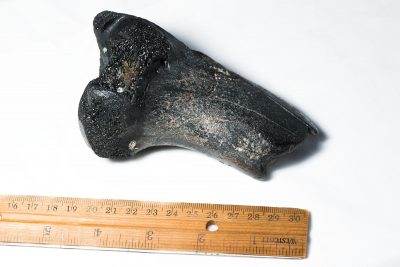With the sun high overhead and days of easterly winds, the ocean here is donning a more tropical hue. Azure blue beyond the outer bar, and clean and green in the surf. It’s days like this that Poseidon begs us to come stroll along the edge of his kingdom. And so, I find myself walking the foreshore, sun drunk and hypnotized, taking advantage of both low tide and high noon.

A large wave stands up on a sandbar. The sun sends light streaming through the water, emerald green with phytoplankton, and revealing the ghostly shapes of dolphins surging forward with the waves. These little cetaceans have herded a school of fish overtop the bar. When a wave rolls in, the fish are swept upwards in the wave, an aquatic prison, albeit momentarily. The dolphins rush in, snatching fish. The wave breaks, fish scatter and the dolphins begin corralling again. Masters of their universe.
Supporter Spotlight
The beach remains littered with the remnants of recent storms. Flotsam and jetsam wash the playa. Much of it “bay barf,” as my wife calls it – the discard of America’s great cities spewed from the mouth of America’s great estuary, the Chesapeake Bay. Some of it is of pelagic origin, like the dead leatherback sea turtle.
I’m walking the wrack line of the storm in search of treasure. My definition of such may vary from yours. Whelk shells, shark’s teeth, 17th century Spanish silver, I’m not picky.
The great waves of storms churn the ocean floor. Old shipwrecks wash up, secrets of the deep are rolled out of their tombs. I’ve yet to experience a storm in which I did not stumble upon something of interest. And so, I walk, and think, and sift through the Bay barf, and flotsam, and jetsam, and pieces of trees, and trash and plastic. We all live downstream.
My eyes que in on something black in the surf. With water temperatures still in the 40s, and me wearing jeans, boots and a long sleeve, I do the only sensible thing of course and wade out into the ocean. The water is cold, but the prospect of discovery makes it bearable. Reaching down into the water up to my shoulder, I grab an obsidian like object.
Walking back up to the beach, I hold the thing up into the air for a better look. Oxygen bathes it for the first time in a long time. The whole thing is only about 5 inches long. It’s jet black. Shiny. Pocked with a few almost microscopic holes. Hollow-ish on the broken side. Unmistakably the distal end of a humerus bone. And it’s extremely heavy for its size.
Supporter Spotlight

This is pay dirt. A fossil. Only that Spanish silver would have been a better score in my book. I head straight back to my truck.
The blackness of this bone can mean different things. On the one hand, a bone trapped in decaying plant matter can be stained black relatively quickly. The beach is littered with bay barf. So, God only knows what’s washing around in our surf right now. On the other hand, a bone trapped in mud can undergo a fossilization process known as mineral replacement.
Mineral replacement occurs when mineral-rich water slowly begins to seep into the bone and dissolve the organic calcium and such. As the bone is dissolved, the mineral load of the water doing the dissolving is left behind. As the name implies, the bone is thus replaced by minerals and becomes a fossil. The whole process takes time to occur – at least 10,000 years.
To tell the difference between a black-stained bone and a black, fossilized bone, there is a quick and dirty test used by amateur fossil hunters the world over. All I need is a needle and a lighter.
If you heat up a stout sewing needle until it turns red, you can get a rough idea as to what you’re dealing with. You can’t actually date the thing this way of course. That would require some amount of organic material to be left inside of this bone, and if the bone itself was less than 100,000 years old, radiometric dating to analyze carbon-14. But, you can at least figure out if this is a fossil or not.
Back at my vehicle, I rifle through the center console in search of these tools. Lighter, needle, flame, heat. What I am paying attention to here is the smell. If it smells kind of like burning hair when the needle is applied, it’s bone. If it doesn’t, then it’s a fossil.
Pressing the red-hot needle tip to the object in question, I lean in close to sniff. If anyone were to pull up right now and see me doing this, well God only knows what they would think. I can only imagine one of the sheriff’s deputies easing up beside me out here on the beach. “Sir, just what in tarnation do you think you’re doing?” said, of course, in a long Southern drawl, assuming they caught me in the act of some new-fangled way of getting high. Kids these days.
“Pressing the red-hot needle tip to the object in question, I lean in close to sniff. If anyone were to pull up right now and see me doing this, well God only knows what they would think.”
I breathe in deeply, millimeters away from the needle. No smell. I try another spot. And then another. I further heat up the needle till its glowing red and burning my fingers. Nothing. This is a fossil. But then again, I knew that already. The weight of the thing gave all that away. Fossils are a whole lot heavier than bone because the calcium has been replaced, and this thing weighs about 10 times what you would expect it to.
From about 2.5 million years to around 10,000 years ago – probably more like 11,700 years – Earth was locked into the age known as the Pleistocene Epoch. This is what people mean when they say the “Ice Age.” During the last glacial maxim, the Laurentide Ice Sheet, a humungous continent-sized glacier that towered 2 miles high and carved out the Great Lakes, came as far south as what’s now New York City.
This was a much colder time. This ice sheet stretched clear across the continent. Everything north was frozen solid. Everything south was, well, different than today.

The Pleistocene was the time of the wooly mammoth, giant ground sloths, short-faced bears, dire wolves and sabretooth cats – whole all lived right here. The world’s freshwater was largely locked up in glaciers, lowering the sea level, and placing the coastline out near the edge of the continental shelf – some 40 miles east from where I plucked this fossil out of the surf. The estuaries of what is now the Carolina coast would have looked more like those in Alaska or the Canadian Maritimes. Atlantic walruses for instance lounged on our beaches, where now they cannot be found south of the Labrador Coast. Arctic species of pelagic birds like auks, puffins and dovekies nested here, as the fossilized remains of gigantic colonies found along our coastal plain reveal. This bone, this black fossil, is from that time.
As to exactly what kind of Ice Age animal this may be, it’s extremely difficult to say. There is not much left of the bone. Its medium in size. Definitely mammal. Definitely humerus. And most likely terrestrial – given the color.
The reason that the black of the fossil suggests a terrestrial species is because of the mud it would have been buried in to create this. Just as our estuaries are ringed in boot-sucking mud today, so too were they during the Pleistocene. Animals that die in the mud, get covered up and remain buried for many thousands of years stand a good chance of being fossilized through mineral replacement. It’s unlikely a whale would have died in inland mud. But then again, many of the fossilized sharks’ teeth found around these parts are also black from mineral replacement.
The shale beds that lie off our coast are the remnants of this. In essence, shale is fossilized mud and the type of rock most likely to have fossils in it. Big storms churn up these shale beds. Breaking loose things sticking out of them and hurling them toward the beach to be found by me.
Given the size, this could be a horse – yes, horses lived here then. It could be a moose. It could be a young bison. A young ground sloth. It could be a dire wolf. Or a sabretooth cat. Or an American lion. It’s probably not a cheetah, as they lived further west. It could even be human, from the Clovis culture that went extinct at the same time as all those other animals. In other words, there were a lot of big-to-medium-sized mammals living here at the time. A lot of big-prey species and a whole lot of big predators. Pleistocene America would have made Africa of today seem tame by comparison.
Finding the fossilized remains of these animals is pretty common stuff along our coast. It might be safe to assume that almost daily someone finds a fossil on our barrier island beaches. And this is the beauty of living at the edge of the sea. That vast expanse of Atlantic that stretches out to blue horizons and beyond, is one of the greatest wildernesses on Earth. Most of us think of places like Yellowstone or Alaska with their wolves and bears and mountains. But it is here, right at our feet, that we can find more super predators that any place on Earth – sharks and whales and great fish like blue fin tuna and marlin. Great treasures lie hidden here, such as that carried by the still-unfound wreck of the El Salvador. New species are still being discovered like the Carolina hammerhead. And it is here, in this blue wilderness, that mysteries and discoveries are still to be had on a 19th century-sized scale.








